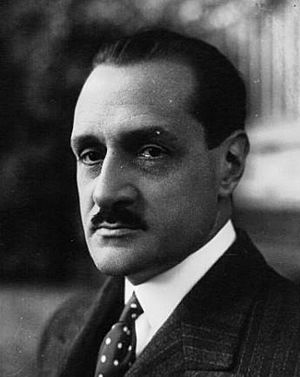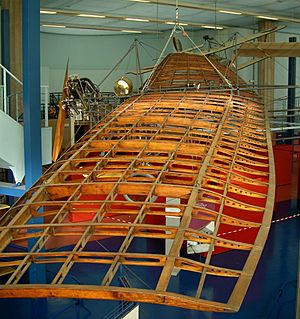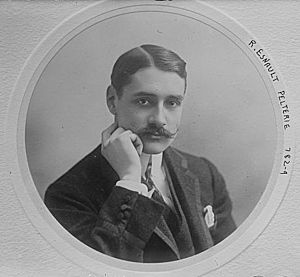Robert Esnault-Pelterie facts for kids
Quick facts for kids
Robert Esnault-Pelterie
|
|
|---|---|

Robert Esnault-Pelterie
|
|
| Born | November 8, 1881 |
| Died | December 6, 1957 (aged 76) |
| Nationality | French |
| Occupation | Engineer |
| Engineering career | |
| Significant advance | |
Robert Albert Charles Esnault-Pelterie (born November 8, 1881 – died December 6, 1957) was a French engineer. He designed airplanes and also studied space travel. Many people see him as one of the main founders of modern rocket science and astronautics. He is often mentioned alongside other famous pioneers like Konstantin Tsiolkovsky from Russia, Hermann Oberth from Germany, and Robert H. Goddard from America.
Contents
Robert Esnault-Pelterie's Life Story
Robert Esnault-Pelterie was born in Paris, France, on November 8, 1881. His father worked in the textile industry. Robert studied engineering at the Sorbonne, which is part of the University of Paris.
He served in World War I. For his service, he received a special honor called Officier de la Légion d'Honneur.
In November 1928, he married Carmen Bernaldo de Quirós. They were on a ship called the Ile de France, sailing to New York City.
Robert Esnault-Pelterie passed away on December 6, 1957, in Nice, France.
How Robert Esnault-Pelterie Designed Airplanes
Esnault-Pelterie created and built airplanes and their engines. He used the name REP for his designs.
Early Airplane Experiments
His first tries at building airplanes were based on the Wright brothers' glider from 1902. He tested his first glider design on a beach near Calais. However, it did not work well. He had not fully understood the Wright brothers' glider.
The Wright brothers used a method called "wing-warping" to control their aircraft. Esnault-Pelterie tried a version of this, but it did not work correctly. He thought it was too dangerous and stopped using it. After that, he came up with the idea of the aileron. These are small moving parts on the wings that help control the plane.
In 1906, he started his first experiments with towed flight. On September 19, 1906, he flew about 500 meters (1,640 feet). He made his first flight using an engine on October 10, 1907. He flew 100 meters (328 feet) with his plane, the REP 1. This plane had a 30-horsepower engine that he designed himself.
Setting Flight Records
Tests of his monoplane, the REP 2, began on June 8, 1908. This aircraft set a record by flying 1,200 meters (3,937 feet). It also reached a height of 30 meters (98 feet).
After a changed version of this plane flew for the last time in 1909, Esnault-Pelterie stopped flying. Instead, he focused on making and improving aircraft.
The Vickers R.E.P. Type Monoplane was based on his designs. This marked the start of aircraft production at the company that later became Vickers Limited. In 1912, he introduced the REP Type N. In 1914, he created the REP Parasol monoplane.
The Invention of the Joystick
His family had put a lot of money into funding his airplane designs. This almost caused them to lose all their money. However, Robert Esnault-Pelterie invented the "joystick" flight control. He also owned a patent for this design.
After World War I, he was involved in legal cases about his joystick patent. Many airplanes built during the war had used his design. The aircraft companies owed him money for using his invention. The money he won from these cases and later payments made him a very rich man. This allowed him to pay back his father's large investment.
Designing Aero Engines
Esnault-Pelterie designed and built his own engines for airplanes. He also sold them under the name R.E.P. These engines were unusual. They had multiple rows of cylinders, like a fan or half-radial shape. His first engine had seven cylinders in two rows and produced 30 horsepower. A later model had 14 cylinders in four rows, making 60 horsepower.
Robert Esnault-Pelterie's Work in Rocketry
Esnault-Pelterie became very interested in space travel. In 1913, he wrote a paper that explained the rocket equation. This equation helps calculate how much energy is needed for a rocket to travel. He also calculated the energy needed to reach the Moon and other planets.
In his paper, he even suggested using atomic energy. He thought 400 kilograms (880 pounds) of radium could power a vehicle traveling between planets. His most important work on this topic was a book called L'Astronautique, published in 1930. A later version in 1934 included more details about interplanetary travel and using nuclear power.
On June 8, 1927, Esnault-Pelterie gave a talk to the Société astronomique de France (French Astronomical Society). The talk was about exploring outer space using rockets. Jean-Jacques Barré attended this talk. He then started writing letters to Esnault-Pelterie about rockets.
In 1929, Esnault-Pelterie suggested the idea of the ballistic missile. This type of missile could be used for military attacks. By 1930, Esnault-Pelterie and Barré convinced the French War Department to fund a study of this idea. In 1931, they started experimenting with different rocket propulsion systems. This included using liquid fuels. In the same year, he showed how a rocket engine powered by gasoline and liquid oxygen worked.
During one experiment with a rocket design, he used a chemical called tetra-nitromethane. There was an explosion, and he lost four fingers from his right hand. Sadly, their work did not create much interest in rocket science within France at that time.
The Prix REP-Hirsch Award
The Prix REP-Hirsch was an international award. The Société astronomique de France gave it to people who studied interplanetary travel and astronautics. Esnault-Pelterie and André-Louis Hirsch, a banker from Paris who loved science, created this award. It was the first award in the world for astronautics.
The award was given "to recognize the best original scientific work... that is able to advance one of the questions related to the realisation of space travel, or to increase human understanding of one of the branches related to the science of astronautics."
The idea for the award came up during a dinner in Paris on December 26, 1927. The guests talked about the new science of space travel. They called it “astronautics,” a name suggested by science fiction writer J.H. Rosny the elder.
Hirsch and Esnault-Pelterie gave money to the Société astronomique de France. They provided 5,000 francs each year for 1928, 1929, and 1930. This money was for an annual award in astronautics named after them. A special committee was set up to manage the prize. The prize was given for 10 years. In 1936, its name changed to the Prix International d'Astronautique.
Some of the people who won the award were:
- 1929 — Hermann Oberth, for all his work in the field.
- 1931 — Pierre Montagne, for his work on gas temperatures inside rocket engines.
- 1934 — Pierre Montagne, for his work on chemical reactions in rockets. Also, Ary Sternfeld for his book.
- 1935 — Jean-Jacques Barré, for his new ideas on solid fuels for rockets.
- 1936 — American Rocket Society and Alfred Africano.
- 1938 — Giovanni Serragli, for his writings on slow-burning powders for exploring the upper atmosphere.
- 1939 — Frank J. Malina and Nathan Carver.
- 2019 — Jacques Blamont.
Even though the award did not last long, it helped create interest in the new science of astronautics. It also encouraged early pioneers in the field.
Robert Esnault-Pelterie's Legacy
Robert Esnault-Pelterie enjoyed horseback riding, playing golf, camping, and driving cars. During his life, he filed about 120 patents. These patents covered many different areas, from working with metals to car suspension systems.
He invented the "center stick" for controlling aircraft. He also invented a new kind of fuel pump. He developed the idea of controlling a rocket's direction by changing the way its engine pushes. This is called vectored thrust.
Honors and Recognition
Robert Esnault-Pelterie received many honors for his work:
- In 1930, he received the Prix Jules Janssen. This is the highest award from the Société astronomique de France, the French astronomical society.
- He became a member of the French Academy.
- A crater on the Moon is named after him: Esnault-Pelterie.
- A street in Paris (rue Robert Esnault-Pelterie) is named in his honor.
- He was inducted into the International Space Hall of Fame as one of its first members.
Books by Esnault-Pelterie
- L'Astronautique, published in Paris, 1930.
- L'Astronautique-Complément, published in Paris, 1935.
Images for kids
See also
 In Spanish: Robert Esnault-Pelterie para niños
In Spanish: Robert Esnault-Pelterie para niños






